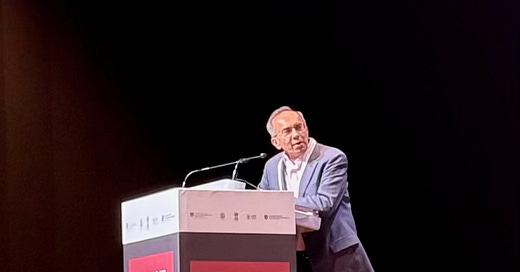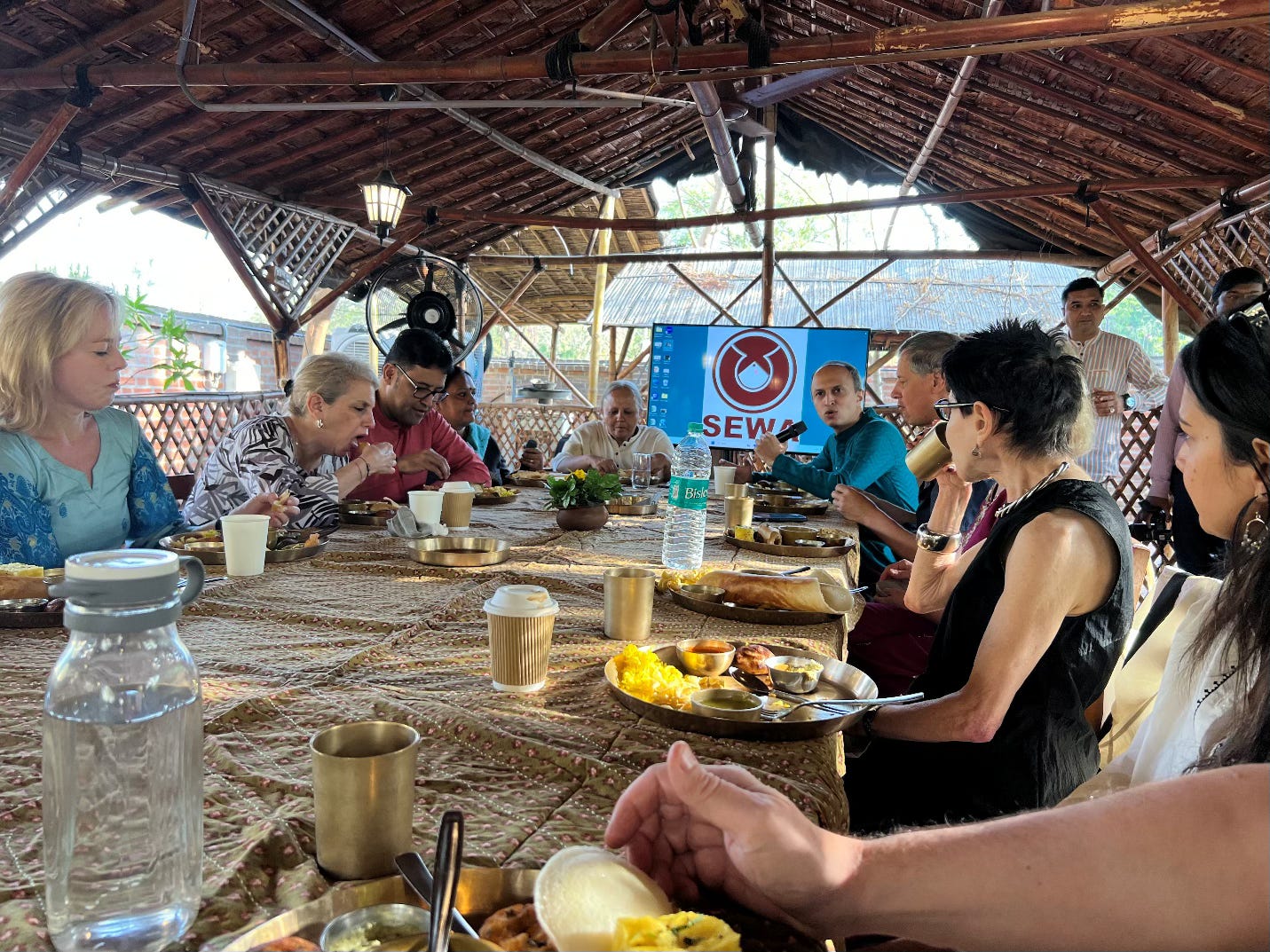Three Simple Truths about Climate Adaptation
What can one do to promote the climate literacy we so sorely need?
Dear readers,
I write this newsletter once every month or so. It features my reflections on the deployment of creativity to making the world’s economic systems (and by extension social and to some extent political systems) more inclusive and, therefore, fairer. That sounds like a tall order – and it is!
If you would like to get the updates directly in your inbox, do subscribe!
At a New Delhi climate resilience conference organized recently by Harvard’s Mittal Institute, India 2047, partnering closely with the Ministry of Environment Forest & Climate Change of the Government of India, a young lady, part of India’s large informal workforce, addressed a largely English-speaking and scientifically-trained audience confidently and crisply in Gujarati. She asked what the relevance was to her, and the livestock on which she depended for her livelihood, of the jargon-filled discussions on El Niño, erraticism in rainfall patterns, genetically modified crops, and other esoterica.
It was a moment that captivated me and, dare I say, much of the room. She’s completely right. The erudite are in an echo chamber, their best intentions notwithstanding. It refocused that discussion, and several others in the ensuing few days of the conference. It was one of the few comments I heard echoed in the halls of Bharat Mandapam, the iconic new structure lent to the conference by the government, attended by over a thousand folks.
The lady was interested in what science could teach her about adapting to the obviously changing climatic conditions amidst which she managed her likely basic existence. To be fair to my academic brethren, there were several among us who echoed that sentiment from the scholarly panels – just not as effectively – professors from the Indian Institute of Tropical Meteorology or the University of California system for example.
It's the punch with which the young lady spoke, and her confident and crisp delivery, that made the difference. It speaks to an ongoing dialog that I have with like-minded colleagues who all recognize that the urgency of the climate message isn’t getting through adequately to the world.
What can one do to promote the climate literacy we so sorely need?
That’s a tough question to answer in its entirety, but since I have been steeped these past couple of years thinking about climate adaptation, let me suggest that we haven’t adhered to a component of effective communication, even though it’s obvious. It’s just that we have to communicate messages that are fit for purpose, tailored to the needs of constituents. Simplicity is key.
Regarding climate adaptation, here are my top-of-mind three relatively simple ideas I’d like to see communicated:
Adaptation is necessary everywhere. I used to think climate mitigation was a rich country thing and adaptation a more poor country thing, as a simple approximation. But just recently, take a look at property insurance markets collapsing in Florida (sea water rise) and Texas (multifarious disasters – floods, hurricanes, wildfires). Migration – getting out of harm’s way – is one form of adaptation. Building ‘defenses’ is another, though even the heroic efforts of our elected officials to build physical barriers these days remind me of the apocryphal story of King Canute’s attempts to hold back the tide (when in fact he might have been demonstrating the futility thereof). It is true, of course, that adaptation remains a more existential issue – human survival is at stake – in the horribly overheated Indo-Gangetic plain or the Persian Gulf, or in the increasingly swampy Bay of Bengal shores of Bangladesh, than it does in Florida.
Adaptation is possible in part in small steps. It’s true that almost ten times as much money has been poured into climate mitigation as it has into climate adaptation – the former being the preoccupation of the rich – but it’s no longer defensible to avoid adaptation because large sums of money aren’t (immediately) available. The world’s largest NGO, BRAC, headquartered in Bangladesh, has long run effective climate adaptation clinics, where it works with rural and urban residents to experiment local solutions to adapt to local contours of change. Our team of academics was generously hosted by SEWA, the world’s largest union of informal women workers, in Ahmedabad, where we witnessed myriad examples of this in urban and semi-urban settings. Ahmedabad’s academic institutions (eg the human-habitat focused institution, CEPT) are doing careful research on new, locally available, materials for new construction, in partnership with SEWA, another form of adaptation.
Nature offers some of the most efficient climate adaptation solutions. We overlook Mother Nature at our peril. Though less about adaptation than about climate mitigation, but worth mentioning are two entrepreneurial teams who are taking this insight to their proverbial banks. Heirloom Carbon in San Francisco, one of the finalists of this year’s XPrize for carbon removal, essentially uses giant beds and towers of limestone to suck carbon dioxide (CO2), perhaps the most significant greenhouse gas (GHG) implicated in the inexorably warming climate, out of the atmosphere (I make it sound simple, the algorithms and material science are of course involved, but the essence is as I stated). Similarly, Brazil’s Re.Green is reforesting denuded forests in the Amazon basin, since trees suck CO2 out of the air as well. Wall Street and Main Street are willing to put hundreds of millions of dollars into these nature-based solutions by paying for the so-called carbon credits that Heirloom and Re.Green earn for their efforts, which are sold to the likes of Microsoft, to offset the latter’s effects on climate via its own GHG emissions.
Of course, we’ve long known that nature works. In Florida, so-called ‘clumping bamboo’ helps sequester carbon and act as a windbreak, rather than grow wild as does ‘running bamboo.’ In California, farmers use temporary heavy rainfalls to flood farmland to replenish groundwater that can be used in drought years. of course, those farms have to grow water-tolerant crops, like pistachios. The Bangalore-based heart surgeon Devi Shetty’s Narayana Health, has built nature friendly hospitals (eg in Mysore and the Cayman Islands) where natural ventilation and appropriate building materials reduce the need for costly and polluting HVAC even in places where life-saving interventions require careful climate control. He’s using nature to adapt to heat.
On the same trip to Ahmedabad, the Italian photographer Claudio Cambon led us down into some of India’s iconic stepwells that he has been diligently photographing these past years as works of art, along with being places of community, and providing water in drought stricken regions. It’s noticeably cooler as one descends. To me, this was a welcome reminder of my childhood in my ancestral home in purani Dilli (old Delhi) – we had deep cellars built into the house’s central courtyard, wherein which we kids spent the hot afternoon hours routinely, pleasantly dark and cool surroundings providing respite from the blazing sun.
Much of the adaptation we need is around us, partly in nature and partly in practices we’ve abandoned inadvertently. We should reclaim those, even while we embrace newer scientific pathways. And we need to tell a better and simpler story to our fellow citizens.






This is an excellent write-up on Climate Adaptation. We observe the challenges of Climate Change, and I see them in Florida, USA. The approaches of the Global North are different from those of the Global South. To me, the solution is that a Global problem needs a Local solution.
Sumit Kundu